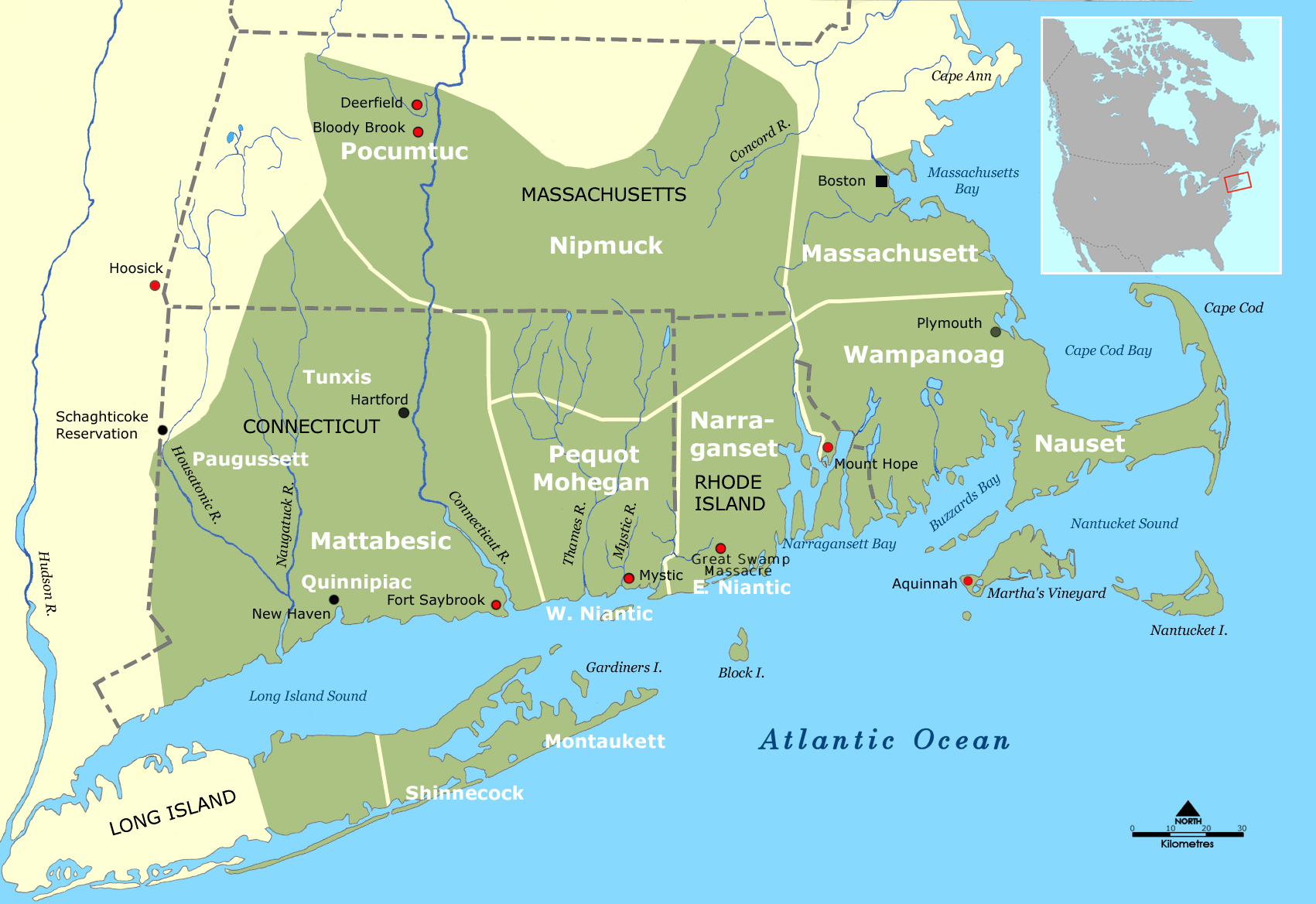|
Chaubunagungamaug Reservation
The Chaubunagungamaug Reservation refers to the small parcel of land located in the town of Thompson, Connecticut, close to the border with the town of Webster, Massachusetts and within the bounds of Lake Chaubunagungamaug (Webster Lake) to the east and the French River to the west. The reservation is used by the descendants of the Nipmuck Indians of the previous reservation, c. 1682–1869, that existed in the same area, who now identify as the Webster/Dudley Band of the Chaubunagungamaug Nipmuck. Together with the Hassanamisco Nipmuc, both have received state recognition under the Massachusetts Commission on Indian Affairs. The reservation only consists of 2.5 acres (1.0 hectare), and does not support a permanent population. It does serve as a meeting place and cultural center for Webster/Dudley Band of the Chaubunagungamaug Nipmuck. The land is also used as a place for the reinterment of local Native American remains. The tribe, and its reservation, are recognized in Massac ... [...More Info...] [...Related Items...] OR: [Wikipedia] [Google] [Baidu] |
Lake Chaubunagungamaug
Lake Chaubunagungamaug, also known as Webster Lake, is a lake in the town of Webster, Massachusetts. It is located near the Connecticut border and has a surface area of 1,442 acres. Since 1921, the lake has also been known by a much longer name having 45 letters comprising fourteen syllables: Lake Chargoggagoggmanchauggagoggchaubunagungamaugg. The lake has become famous beyond Central Massachusetts for having the longest name of any geographic feature in all of the United States. Name The lake's name comes from Loup, an Algonquian language, and is often said to mean, "Fishing Place at the Boundaries—Neutral Meeting Grounds". A more fitting translation is "lake divided by islands", according to anthropologist Ives Goddard. Today, "Webster Lake" may be the name most used, but some (including many residents of Webster) take pride in reeling off the longer versions. This lake has several alternative names. Lake Ch ... [...More Info...] [...Related Items...] OR: [Wikipedia] [Google] [Baidu] |
Natick, Massachusetts
Natick ( ) is a town in Middlesex County, Massachusetts, United States. It is near the center of the MetroWest region of Massachusetts, with a population of 37,006 at the 2020 census. west of Boston, Natick is part of the Greater Boston area. Massachusetts's center of population was in Natick at the censuses of 2000-2020, most recently in the vicinity of Hunters Lane. Name The name ''Natick'' comes from the language of the Massachusett Native American tribe and is commonly thought to mean "Place of Hills." A more accurate translation may be "place of ursearching," after John Eliot's successful search for a location for his Praying Indian settlement. History Natick was settled in 1651 by John Eliot, a Puritan missionary born in Widford, England, who received a commission and funds from England's Long Parliament to settle the Massachusett Indians called Praying Indians on both sides of the Charles River, on land deeded from the settlement at Dedham. Natick was the first o ... [...More Info...] [...Related Items...] OR: [Wikipedia] [Google] [Baidu] |
List Of Indian Reservations In The United States
This is a list of Indian reservations and other tribal homelands in the United States. In Canada, the Indian reserve is a similar institution. Federally recognized reservations There are 326 Indian Reservations in the United States. Most of the tribal land base in the United States was set aside by the federal government as Native American Reservations. In California, about half of its reservations are called rancherías. In New Mexico, most reservations are called Pueblos. In some western states, notably Nevada, there are Native American areas called Indian colonies. Populations are total census counts and include non-Native American people as well, sometimes making up a majority of the residents. The total population of all of them is 1,043,762. Federally recognized trust lands Alaska Native village statistical areas Alaska Native Village Statistical Areas are geographical areas the United States Census Bureau uses to track demographic data. These statistical areas ... [...More Info...] [...Related Items...] OR: [Wikipedia] [Google] [Baidu] |
State-recognized Tribes
State-recognized tribes in the United States are organizations that identify as Native American tribes or heritage groups that do not meet the criteria for federally recognized Indian tribes but have been recognized by a process established under assorted state government laws for varying purposes. State recognition does not dictate whether or not they are recognized as Native American tribes by continually existing tribal nations. In the late 20th century, some states have passed legislation that recognizes some tribes. Most such groups are located in the Eastern United States, including the three of largest state-recognized tribes in the US, the Lumbee Tribe of North Carolina, Echota Cherokee Tribe of Alabama, and the United Houma Nation of Louisiana, each of which has more than ten thousand members. State recognition confers few benefits under federal law. It is not the same as federal recognition, which is the federal government's acknowledgment of a tribe as a dependent s ... [...More Info...] [...Related Items...] OR: [Wikipedia] [Google] [Baidu] |
Native American Tribes In Massachusetts Native American tribes in Massachusetts are the Native American tribes and their reservations that existed historically and those that still exist today in what is now the Commonwealth of Massachusetts. A Narragansett term for this region is Ninnimissinuok. Federally recognized tribes Massachusetts has two federally recognized tribes. They have met the seven criteria of an American Indian tribe: being an American Indian entity since at least 1900, a predominant part of the group forms a distinct community and has done so throughout history into the present; holding political influence over its members, having governing documents including membership criteria, members having ancestral descent from historic American Indian tribes, not being members of other existing federally recognized tribes, and not being previously terminated by the U.S. Congress. * Mashpee Wampanoag Tribe * Wampanoag Tribe of Gay Head (Aquinnah) State-recognized tribes State-recognized tribes do not h ... [...More Info...] [...Related Items...] |





